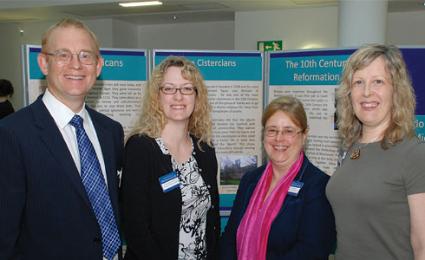Men in the Middle Ages
Fri, 03 Aug 2012 13:13:00 BST
Lecturers launch new research group to investigate medieval masculinity
WHETHER you were a cleric grappling with a life of celibacy or a noble forced to demonstrate his virility in combat, what was it like to be a man in the Middle Ages?
The study of medieval masculinity is a burgeoning field of international scholarship and two historians at the University of Huddersfield are playing a key role. They recently staged a conference which attracted experts from around the world. And they have launched a new network, which will be an important forum for research in the field.
Dr Pat Cullum and Dr Katherine Lewis (pictured below) are the Huddersfield historians who organised the conference, entitled ‘Religious Men in the Middle Ages’. Taking place over two days, it was attended by 50 delegates from 14 countries, including the USA, Finland, China, Italy and Cyprus. There were 40 papers at a sequence of sessions which dealt with topics such as medieval bishops, pilgrimage, monastic orders and the religious outlook of lay people.
(left to right: Dr Katherine Lewis, Dr Pat Cullum and Dr Joanna Huntington, University of Lincoln, UK)
 Now Dr Cullum and Dr Lewis have announced the formation of a network named ‘The Bishop’s Eye’.
Now Dr Cullum and Dr Lewis have announced the formation of a network named ‘The Bishop’s Eye’.
Dr Lewis explained: “This network will foster new research into the lives, experiences and representation of medieval religious men, both those following a professional vocation – bishops, monks and priests for example – and laymen.
“We’ve taken its name from a famous stained glass window in Lincoln Cathedral, because the project is a collaboration with our colleagues Dr Philippa Hoskin and Dr Joanna Huntington, of the University of Lincoln. We hope to bring together scholars working across the medieval period in a variety of fields, and employing a range of conceptual approaches.”
It is intended that biennial conferences on the lives of medieval men will be organised under the aegis of The Bishop’s Eye, and there will be publication of the proceedings. Also, it is hoped to attract new scholars into the field. The University of Huddersfield has announced that it will offer two full fee-waiver PhD scholarships to suitable candidates.
It was 12 years ago that Dr Cullum and Dr Lewis helped to foster the subject of medieval masculinity as a field of research, when they organised a conference on holiness and masculinity in the Middle Ages.
“At the time we were just beginning to think about religious masculinity and there weren’t any experts in the field – we were all very much pioneers,” said Dr Cullum. “Katherine and I thought that after more than ten years it was a good time to revisit the field and see how things are developing.
“There are clearly many more people interested, more postgraduate students working in the field and the sophistication of analysis has developed significantly. People are using a broader range of subject matter and all kinds of sources and approaches.”
(Pictured with the University’s Dr Pat Cullum and Dr Katherine Lewis are Professor Michael Satlow, Brown University, Rhode Island, USA, and Dr Jennifer Thibodeaux, University of Wisconsin, Whitewater, USA)

The recent University of Huddersfield conference covered a period of a thousand years – from the 6th to the 16th centuries – and the organisers were determined to cover a wide range of religious cultures.
“One of the things we wanted to do this time was to get people talking about more than just Catholic Christendom, so we had papers on Orthodoxy, Jewish masculinity and a comparison between St Francis of Assisi and the Buddha,” said Dr Cullum.
Celibacy for the clergy was one of the key topics. It was in the 10th century that Papacy and church began to argue that priests should be celibate, although it was some 200 years before the idea was widely accepted.
“There were a number of justifications, for example that a priest should imitate Christ, who was celibate, and there was an argument that priests who were handling the sacraments had to be unpolluted by sexual activity,” explained Dr Cullum.
“There was also a practical argument that the church wanted to retain control of its property and if priests wanted to marry and have children they were always going to be tempted to give church property to their families.”
One of the themes that emerged at the University of Huddersfield conference was that there considerably more resistance to clerical celibacy than previously thought, said Dr Cullum.
She added that research into medieval masculinity is a much more recent development than the study of women’s lives in the Middle Ages – a well-established field.
“But we have had relatively little study of men as gendered beings, so we need to think about whether elements that we have identified as, for example, women’s piety really were that or whether they were something that men participated in as well. We are trying to explore whether men did other things or did them differently,” said Dr Cullum.
“It is about developing a recognition that both men and women are gendered beings.”







